Wild San: Who Really is Princess Mononoke?
San: Why did you stop me from killing her? Tell me while you're still alive!
Ashitaka: I didn't want them to kill you. That's why.
San: I'm not afraid to die. I'll do anything to get you humans out of my forest!
Ashitaka: I knew that... from the first moment I saw you.
San: And I'm not afraid of you! I should kill you for saving her!
[San turns Ashitaka around, pulls out his sword, and points it just above his neck]
That woman is evil, and there's no one who can stop me from killing her.
Ashitaka: No... Live...
San: Enough! I'm not listening to you anymore!
[presses the sword tip to Ashitaka's throat]
Ashitaka: [opening his eyes] You're... beautiful...
[San steps back, surprised]
About the Movie “Mononoke Hime”
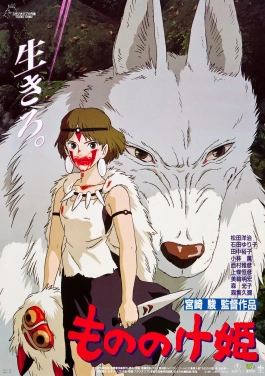
Over the years, "Princess Mononoke" has maintained its popularity, being not just a cult work in Japan but also gaining broad international recognition. It has been the subject of numerous analyses and interpretations, ranking high in lists of the best anime films of all time. According to box office data, the film earned over $159 million worldwide, testifying to its extraordinary reception by both critics and audiences.
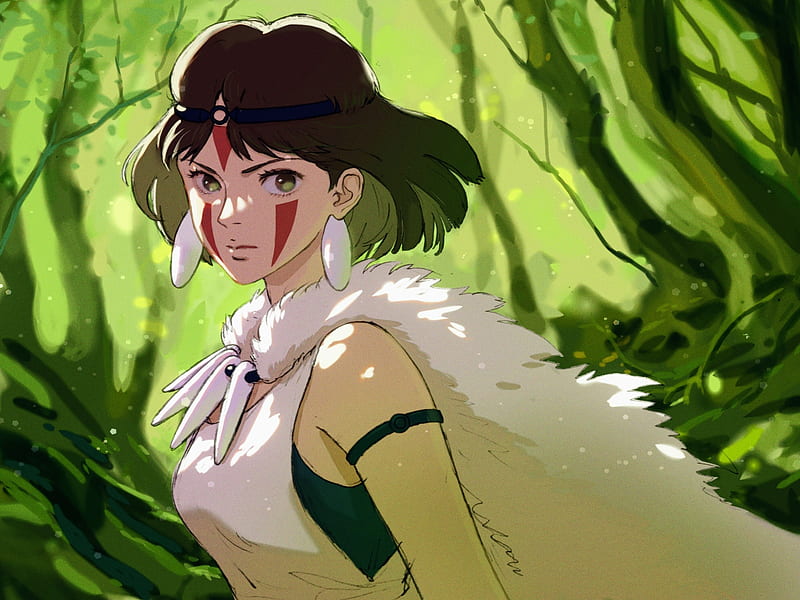
Hints in the Name
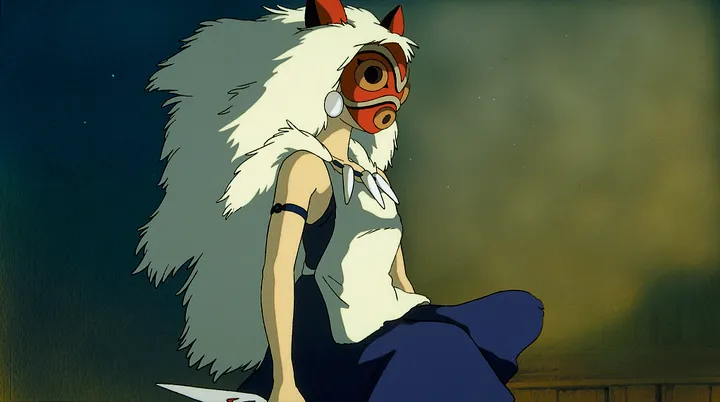
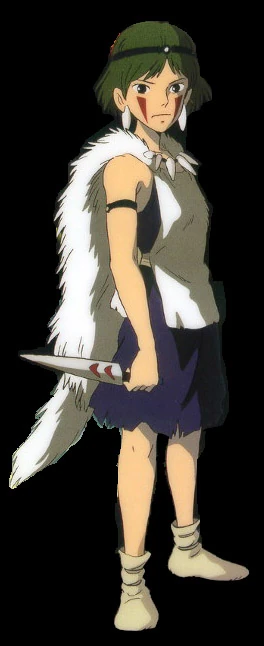
There are other, extra-narrative reasons as well. Namely, the fact that in the original concept of "Princess Mononoke," San was to be the third princess of a kingdom, sent to marry a monster, hence her name San, meaning "three." However, later changes in the film's plot led to the current portrayal of San as the third "child" of the wolf goddess Moro. This evolution of San's name and character emphasizes her development from a traditional princess role to a more complex and symbolic figure, who combines human and natural elements, becoming a key character in a world where the boundaries between human and natural are fluid."

- San, returning to the wolf den after interacting with humans
Abandoned by Humans, Raised by Wolves
San's story begins with the dramatic events of her childhood, which set the direction for her entire life. As an infant, San was abandoned by her parents in a desperate attempt to escape from the wolf goddess Moro. In a contrasting act of mercy and maternal care, Moro, despite her wild nature, decided to take care of the helpless child. These events are not directly shown in the film – they can be inferred from various statements of the anime characters. Being raised by the wolf goddess Moro deep in the wilderness shaped San's identity, beliefs, and worldview. Growing up, San identified more with wolves and forest spirits than with humans, which determined her unique role in the conflict between the natural world and the civilizational aspirations of humanity. In reality, she did not consider herself human, or at least suppressed it as something painful and unbearable.
Having spent her entire life in the depths of the forest, among wolves and spirits, San became a strong, independent, and deeply nature-bound person. Her personality and attitudes are a direct reflection of the environment in which she grew up. Raised by Moro, San learned to respect nature and its inhabitants, which is evident in her unyielding stance to protect the forest from human threats. Her wild manners, survival skills, and deep bond with wolves and other forest inhabitants are a reflection of her unique upbringing. San does not see herself as a human but as an integral part of the forest world, leading to a conflict between her natural instincts and the human side of her being.
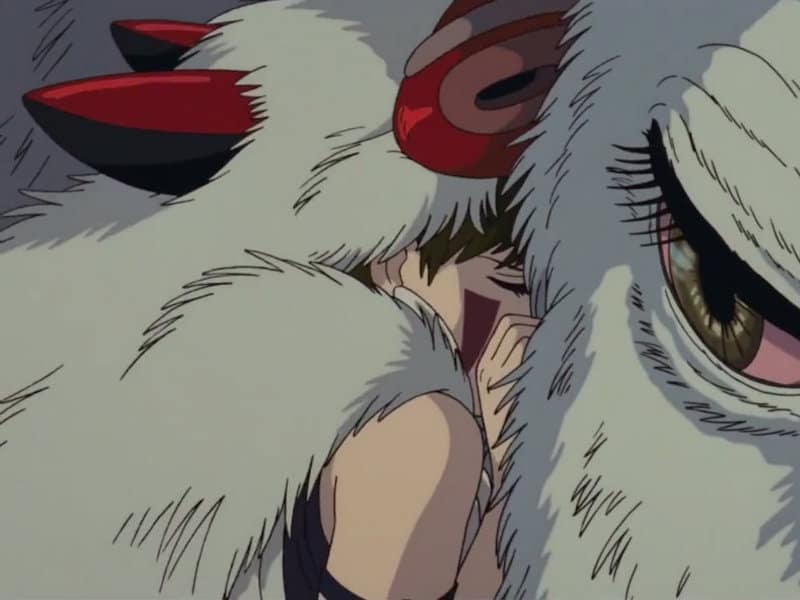
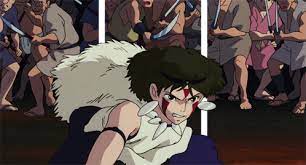
- San, during her first confrontation with Ashitaka
San as the Embodiment of the Conflict Between Man and Nature
San represents the strength and rawness of nature. Her conflict with humans, who destroy the forest in the name of development and progress, is expressed in her determination to defend her home at all costs. This conflict is symbolic of the main theme of the film, which is the collision of two worlds: the traditional, nature-respecting one, and the modern, based on the exploitation of natural resources. San, standing on the side of nature, becomes a symbol of the fight against environmental destruction, emphasizing the need to find a balance between human needs and the protection of nature.
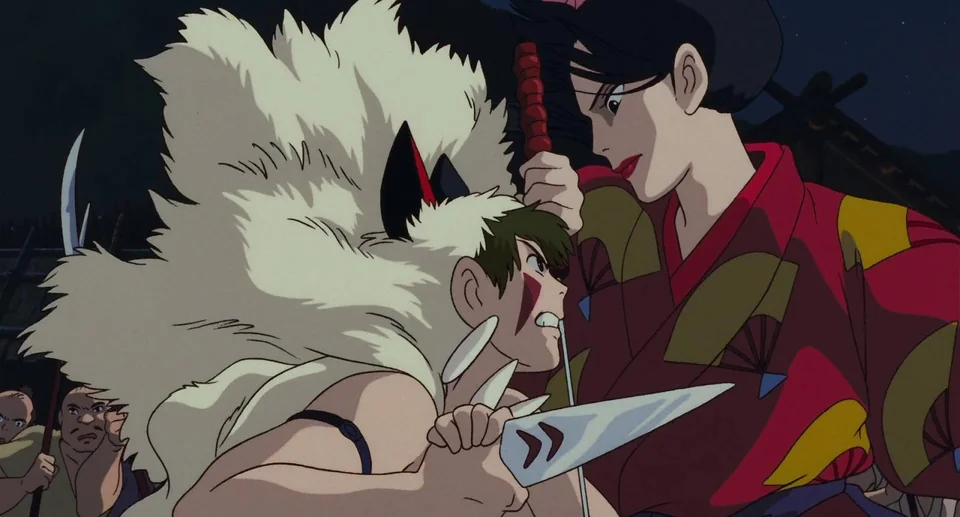
San, being deep down a human, despite her strong aversion to humans, experiences an internal conflict regarding her identity. This dilemma is particularly revealed in her interactions with Ashitaka, a character who, though human, shows deep respect for nature and strives for harmonious coexistence of both worlds. Unlike Lady Eboshi, who represents the expansive and destructive nature of humanity, Ashitaka symbolizes the possibility of symbiosis and understanding between humans and nature.
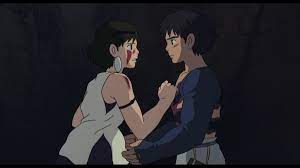
This understanding, though developing gradually, is crucial for the evolution of San as a character. Through her interaction with Ashitaka, she begins to understand that the boundaries between nature and humanity are not as rigid as she initially thought, and the world of humans can contain both goodness and respect for nature. This change in San's perception is subtle but significant, reflecting the deeper message of the film about the complexity and multidimensionality of human nature and the possibility of finding a balance between our civilizational aspirations and the need for protection and respect for the natural environment.
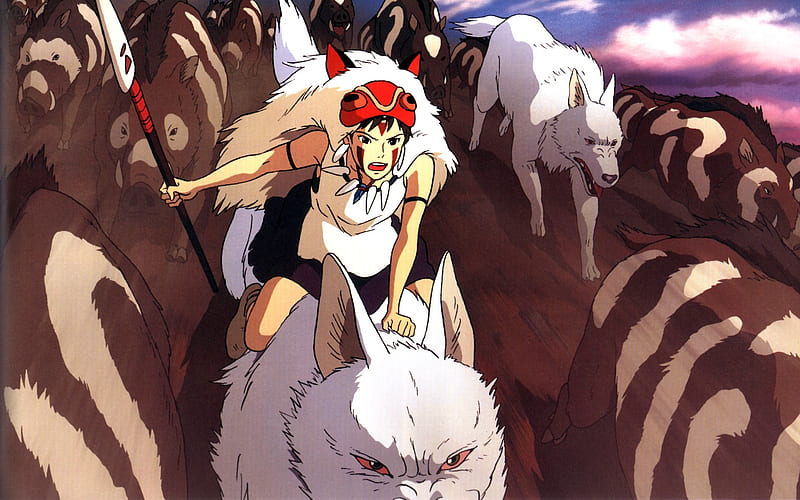

- San, during the confrontation with the tribe of boars.
San – The "Princess" Wild and Independent
In Japanese culture and animation, the princess character often reflects ideals of delicacy, grace, and passivity – traits deeply rooted in traditional concepts of femininity. However, San from "Princess Mononoke" represents a radical departure from these stereotypes. Her character is raw, wild, and independent, making her unique among female characters in anime (though in Miyazaki's work, not so much...). San not only survived in the brutal world of nature but became its undisputed defender. She is a warrior whose strength and courage match her male counterparts, a stark contrast to the traditional depiction of women in Japanese tradition.
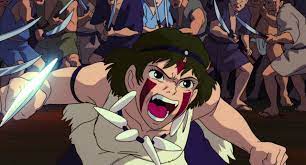


- San, determined in the face of inevitable destruction of nature.
San's Relationship with Forest Inhabitants
San's relationship with Moro, the wolf goddess who raised her, plays a key role in shaping her identity and attitudes. Moro, presented as a powerful and respected figure in the forest world, not only provided San with shelter and care but also taught her the values and rules governing nature. San, adopted by Moro and treated as her own child, develops a sense of belonging to the natural world, which is fundamental to her conflicts with humans and subsequent actions in the film.
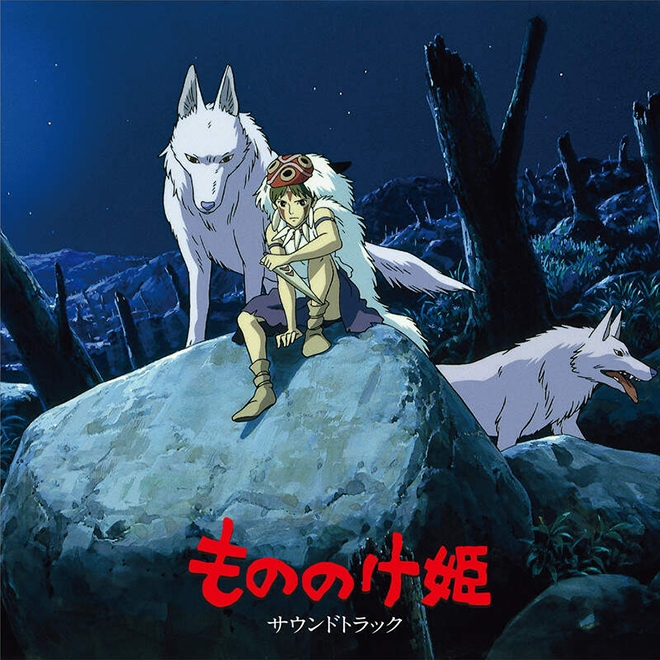
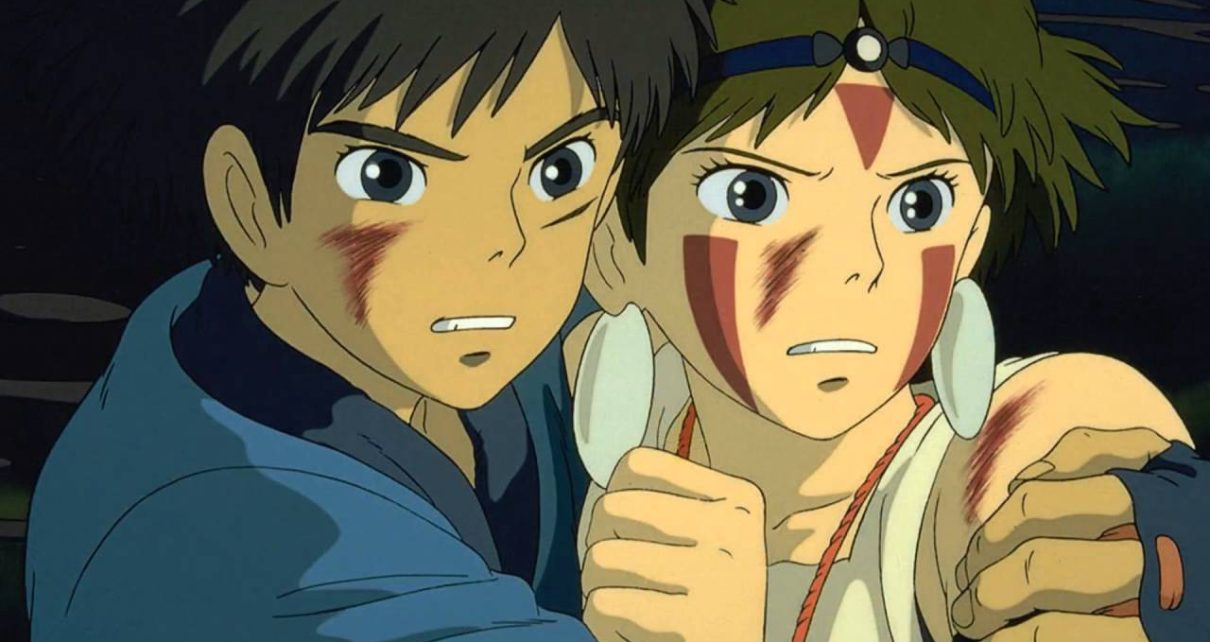
The Forest Spirit is dead."
- San, disheartened after the death of the Forest Spirit
Shintoist Motifs in "Princess Mononoke" and their Reflection in San's Character
Hayao Miyazaki's "Princess Mononoke" is a film deeply rooted in the ideas of Shintoism, Japan's indigenous religion, which emphasizes harmony between humans and nature. Shintoism is based on the belief in kami - spirits or deities present in all aspects of the natural world, from stones and trees to animals and places. In the film, kami are represented by various forest spirits, including Shishigami - a forest deity in the form of a giant deer, symbolizing the balance between life and death. San, raised by the wolf goddess Moro, lives in a world where the boundary between natural and supernatural is fluid, and respect for kami is a fundamental aspect of existence. Her deep bond with nature and forest animals, as well as her conflict with humans destroying the forest, reflects the Shintoist idea of protecting the sanctity of nature.
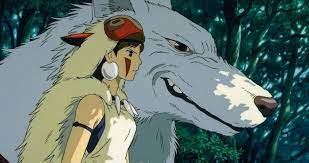
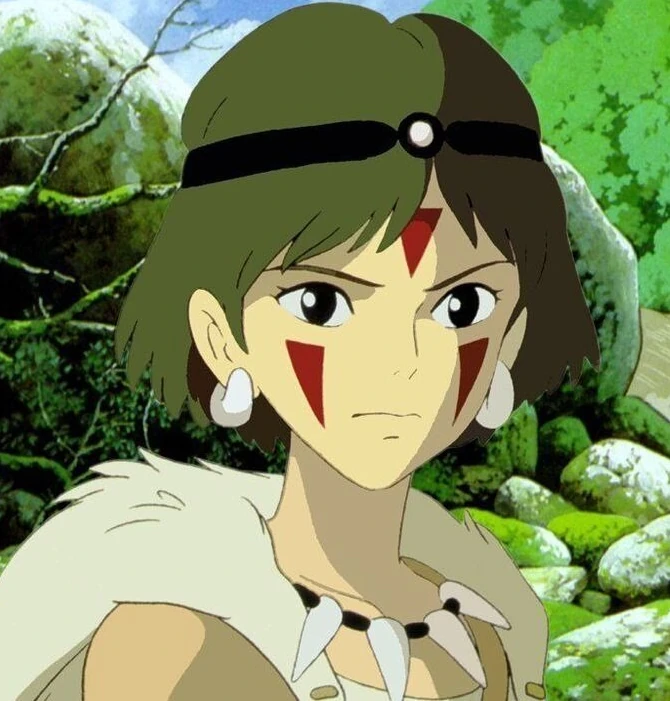
Interestingly, the design of San's tattoos is likely based on the tattoos of the character Kodowa from Daijiro Moroboshi's works. This inspiration highlights how deeply rooted elements of Japanese culture are in the film and how important it is to understand these influences in the context of interpreting San's character. These tattoos not only strengthen her visual connection with the wild nature but may also have deeper cultural and symbolic significance, reflecting influences of Japanese art and mythology.
San's Message
The character of San from "Princess Mononoke" and the film itself have become icons in not just Japanese culture but globally. San, as a character whose wildness and deep bond with nature collide with traditional perceptions of female delicacy, has paved new paths in portraying female characters in animation and cinema. As a strong, independent, and complex character, San speaks to a new generation of viewers seeking authentic and unconventional heroes. Her story, reflecting global environmental concerns and respect for nature, remains relevant and resonates with an increasing number of people worldwide.
Ecology: The film not only presents a conflict between nature and technological progress but also emphasizes the need to find harmony and balance. San, as a defender of the forest, symbolizes deep respect for nature and also promises a future reconciliation of living in harmony with nature with development and civilization.
Feminism: San, as a character, has had a significant impact on feminist interpretations in animation. Crossing the boundaries of traditional gender roles, she has become an inspiration for creators and audiences seeking stronger, more independent female characters. Her character goes beyond stereotypes, presenting a woman as active, self-sufficient, and influential.
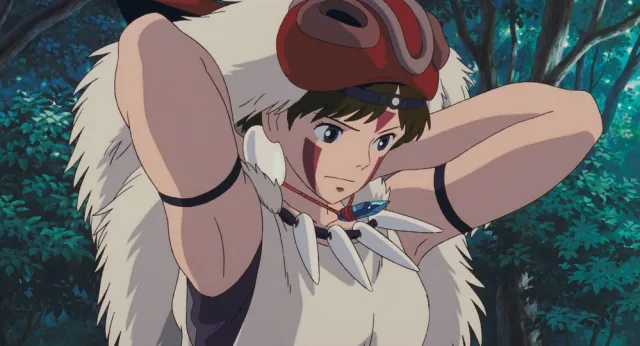
As a result, "Princess Mononoke" and the character of San remain not only important elements of contemporary culture but also a symbol of social changes and ecological awareness. The film, being a timeless masterpiece, continues to inspire and provoke discussions on topics important to today's society. The character of San, as a symbol of strength, independence, and deep connection with nature, remains a significant reference point in conversations about the role of women, ecology, and spirituality in art and life.
“Many of my movies have strong female leads—brave, self-sufficient girls that don't think twice about fighting for what they believe with all their heart.
They'll need a friend, or a supporter, but never a savior.”
- Hayao Miyazaki
SEE ALSO SIMILAR ARTICLES:
"Strong Japanese Women"
see book by the author
of the page
未開 ソビエライ
An enthusiast of Asian culture with a deep appreciation for the diverse philosophies of the world. By education, a psychologist and philologist specializing in Korean studies. At heart, a programmer (primarily for Android) and a passionate technology enthusiast, as well as a practitioner of Zen and mono no aware. In moments of tranquility, adheres to a disciplined lifestyle, firmly believing that perseverance, continuous personal growth, and dedication to one's passions are the wisest paths in life. Author of the book "Strong Women of Japan" (>>see more)
Personal motto:
"The most powerful force in the universe is compound interest." - Albert Einstein (probably)
Mike Soray
(aka Michał Sobieraj)
未開 ソビエライ
An enthusiast of Asian culture with a deep appreciation for the diverse philosophies of the world. By education, a psychologist and philologist specializing in Korean studies. At heart, a programmer (primarily for Android) and a passionate technology enthusiast, as well as a practitioner of Zen and mono no aware. In moments of tranquility, adheres to a disciplined lifestyle, firmly believing that perseverance, continuous personal growth, and dedication to one's passions are the wisest paths in life. Author of the book "Strong Women of Japan" (>>see more)
Personal motto:
"The most powerful force in the universe is compound interest." - Albert Einstein (probably)
Mike Soray
(aka Michał Sobieraj)
Write us...
Ciechanów, Polska
dr.imyon@gmail.com
___________________
inari.smart
Would you like to share your thoughts or feedback about our website or app? Leave us a message, and we’ll get back to you quickly. We value your perspective!






